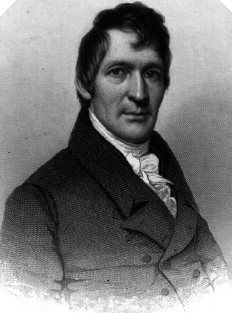
The 9th United States Congress was a meeting of the legislative branch of the United States federal government, consisting of the United States Senate and the United States House of Representatives. It met in Washington, D.C., from March 4, 1805, to March 4, 1807, during the fifth and sixth years of Thomas Jefferson's presidency. The apportionment of seats in the House of Representatives was based on the 1800 United States census. Both chambers had a Democratic-Republican majority.

Isaac Tichenor was an American lawyer and politician. He served as the third and fifth governor of Vermont and United States Senator from Vermont.
These are tables of congressional delegations from Vermont to the United States Senate and United States House of Representatives.
James Elliot was an American soldier, lawyer, author and politician. A holder of local and state offices throughout his life, he was most notable for his service as a United States representative from Vermont.

The 1806–07 United States House of Representatives elections were held on various dates in various states between April 29, 1806 and August 4, 1807. Each state set its own date for its elections to the House of Representatives before the first session of the 10th United States Congress convened on October 26, 1807. They occurred during Thomas Jefferson's second term. Elections were held for all 142 seats, representing 17 states.
Shearjashub Bourne was an American lawyer, jurist, and politician from Massachusetts who served in the Massachusetts House of Representatives and United States House of Representatives.

Benjamin Swift was an American lawyer, banker and politician from Vermont. He served as a United States Representative and United States Senator, and helped found the Whig Party.
Mark Richards was an American politician. He served as a member of the United States House of Representatives from Vermont and as the ninth lieutenant governor of Vermont.

Ernest Willard Gibson was an American politician and lawyer from Vermont. A Republican, he served in both the United States House of Representatives (1923-1933) and United States Senate (1933-1940).

Ezra Butler was an American clergyman, politician, lawyer, judge, the 11th governor of Vermont, and a United States representative from Vermont.

Cornelius Peter Van Ness was an American politician and diplomat who served as the tenth governor of Vermont from 1823 to 1826 and Envoy Extraordinary and Minister Plenipotentiary to the Kingdom of Spain from 1829 to 1836. Van Ness was a Democratic-Republican and later a Democrat.
Henry Olin was an American lawyer and politician. He served as a United States representative from Vermont and eighth lieutenant governor of Vermont.
Daniel Buck was an American lawyer and politician. He served as a United States representative from Vermont.
Charles Rich was an American lawyer and politician. He served as a Democratic-Republican United States representative from Vermont.

Richard Fletcher was a member of the United States House of Representatives from Massachusetts. The brother of Governor Ryland Fletcher, he was born in Cavendish, Vermont on January 8, 1788. He pursued classical studies and graduated from Dartmouth College in 1806. He taught school in Salisbury, New Hampshire, studied law, was admitted to the bar and commenced practice there.
James Strong was a United States representative from New York.
Side judge, or assistant judge, is a judicial position unique to the U.S. state of Vermont. There are two side judges in each of Vermont's 14 counties. Like lay judges, side judges are usually not legal professionals.

Following the September 1808 election for delegates to represent Vermont in the 11th United States Congress, two of its four districts had failed to choose representatives. A second ballot was held in December, giving Vermont a total of three Federalist representatives and one Democratic-Republican.
This page is based on this
Wikipedia article Text is available under the
CC BY-SA 4.0 license; additional terms may apply.
Images, videos and audio are available under their respective licenses.









